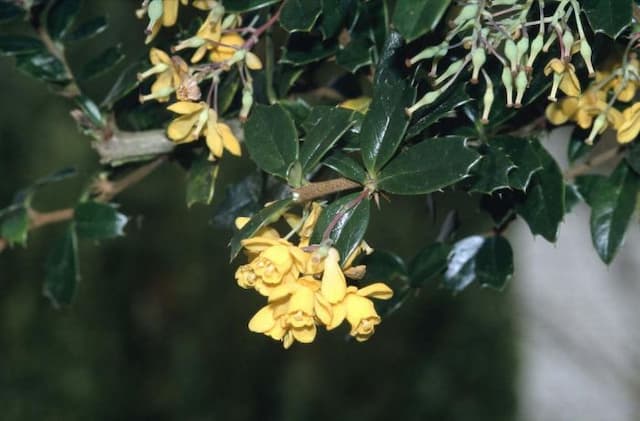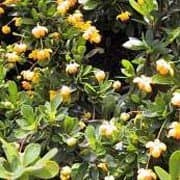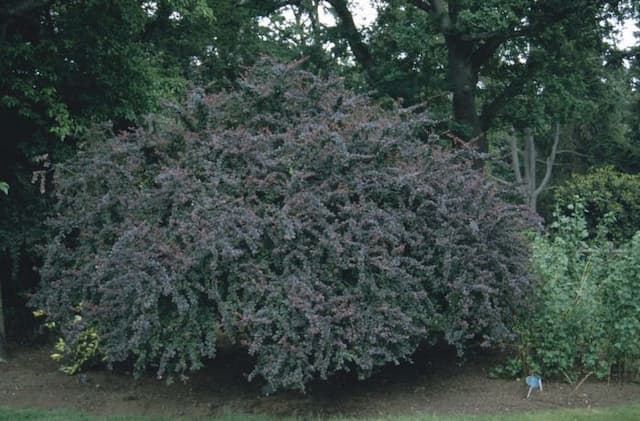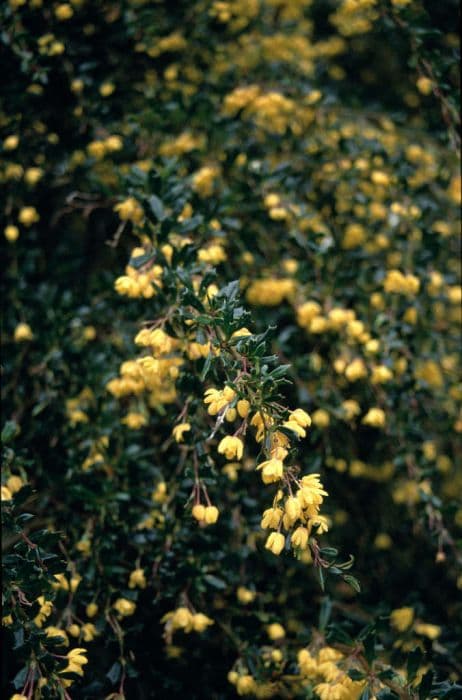Himalayan Mayapple Sinopodophyllum hexandrum

ABOUT
Sinopodophyllum hexandrum, commonly known as Himalayan mayapple, has a unique and striking appearance. It features large, umbrella-like leaves that are deeply divided into multiple lobes, giving them a somewhat circular shape when viewed from above. These leaves are a lush, dark green color and have a slightly glossy texture, often contributing to a lush, exotic look in the environments where it thrives. Emerging in the springtime, the Himalayan mayapple has a single flower that is distinctive for its bell-like shape and pendulous habit, hanging gracefully beneath the leaves. Typically, the blossoms are a waxy shade of white or pink, sometimes having speckles or subtle gradients of color. These flowers ultimately give way to fleshy fruits in late summer or early autumn, which are spherical in shape and ripen to a golden-yellow hue, often speckled or blushed with a soft red. The sturdy stems of the Himalayan mayapple are upright and bear the foliage and flower singularly, creating a very focused and architectural display of its parts. The visual character of this plant is one of elegance and exotic charm, often making it a point of interest in shaded garden spaces where its robust foliage can thrive in the cooler understory.
About this plant
 Names
NamesFamily
Berberidaceae.
Synonyms
Himalayan Mayapple, Indian Mayapple, Himalayan Podophyllum, Himalayan Mandrake.
Common names
Podophyllum emodi, Podophyllum hexandrum.
 Toxicity
ToxicityTo humans
The most common common name of Sinopodophyllum hexandrum is Himalayan Mayapple. This plant contains podophyllotoxin, which is toxic to humans. Ingesting any part of the plant, especially the rhizomes and fruit, can lead to poisoning. Symptoms of poisoning may include diarrhea, vomiting, throat burning, headache, dizziness, difficulty breathing, low blood pressure, and in severe cases, it can cause multi-organ failure or death. Handling the plant may also cause skin irritation.
To pets
Himalayan Mayapple is also toxic to pets, including cats and dogs. The plant's pods, seeds, leaves, and stems contain podophyllotoxin, which can cause symptoms such as vomiting, diarrhea, lethargy, drooling, and in severe cases, tremors, seizures, or coma if ingested. Immediate veterinary care is essential if a pet is suspected of ingesting any part of the plant.
 Characteristics
CharacteristicsLife cycle
Perennials
Foliage type
Deciduous
Color of leaves
Green
Flower color
White
Height
1-2 feet (30-60 cm)
Spread
1-1.5 feet (30-45 cm)
Plant type
Herb
Hardiness zones
5
Native area
Himalayas
Benefits
 General Benefits
General Benefits- Ornamental value: Sinopodophyllum hexandrum, commonly known as Himalayan mayapple, is prized in gardens for its attractive foliage and flowers, adding aesthetic appeal to shade gardens.
- Cultural significance: It holds cultural importance in certain regions, particularly in the Himalayas, where it is native and can be part of traditional landscaping practices.
- Biodiversity support: The plant provides habitat and food for various insects and animals, thus playing a role in maintaining local biodiversity.
- Soil stabilization: The Himalayan mayapple, with its spreading rhizomes, can help in soil stabilization, thereby preventing erosion in sloped and mountainous terrains.
- Shade tolerance: Being naturally adapted to grow in shady conditions under the forest canopy, it is an ideal groundcover for woodland gardens or shaded areas.
 Medical Properties
Medical Properties- Anticancer properties: The rhizomes of Sinopodophyllum hexandrum, commonly known as Himalayan mayapple, contain podophyllotoxin, which is used as a starting material for the semi-synthesis of cancer drugs.
- Antiviral activity: Podophyllotoxin, derived from the plant, has been used to treat external genital warts caused by the human papillomavirus (HPV).
- Laxative effects: Like other members of the genus, the plant has been used historically as a strong laxative when ingested, but such use is risky due to its toxic nature and is not recommended.
 Air-purifying Qualities
Air-purifying QualitiesThis plant is not specifically known for air purifying qualities.
 Other Uses
Other Uses- The common name of Sinopodophyllum hexandrum is Himalayan mayapple, and it has been traditionally used as a dye, with the roots providing a distinct yellowish color to wool and other natural fibers.
- In some cultures, Himalayan mayapple is used as an insect repellent, with the leaves believed to ward off various insects when placed among clothes or other materials.
- Gardeners may cultivate Himalayan mayapple for ornamental purposes due to its attractive foliage and flowers, particularly in shade gardens or woodland settings.
- Some enthusiasts of natural photography may seek out Himalayan mayapple because of its visually appealing fruit and leaves, making it a subject for botanical photography.
- The Himalayan mayapple's fruit, while not widely consumed, has been used locally to make small quantities of preserves or jellies in areas where it grows naturally.
- Traditionally, Himalayan mayapple rhizomes have been used to make a natural yellow-orange to brown dye for textiles and handicrafts.
- Beyond its ornamental value, the dense foliage of Himalayan mayapple provides ground cover in gardens, helping to reduce soil erosion in hilly areas.
- Ecologically, the Himalayan mayapple plant plays a role in sustaining local bee populations by providing nectar during its blooming season.
- The plant has been used as a component in creating fragrances and essential oils, despite the rarity of this application.
- Due to its rarity and specific growing conditions, Himalayan mayapple may be utilized in conservation education to raise awareness about plant diversity and habitat protection.
Interesting Facts
 Feng Shui
Feng ShuiThe Mayapple is not used in Feng Shui practice.
 Zodiac Sign Compitability
Zodiac Sign CompitabilityThe Mayapple is not used in astrology practice.
 Plant Symbolism
Plant Symbolism- Adaptability: Known for thriving in harsh, mountainous environments, Sinopodophyllum hexandrum or Himalayan Mayapple represents the ability to adapt to challenging conditions and survive against the odds.
- Protection: Due to its toxic properties, Himalayan Mayapple is seen as a symbol of protection, deterring negative forces and providing a sense of security.
- Healing: With its use in traditional medicine, particularly in the production of anti-cancer drugs, this plant signifies healing and the power of nature to restore health.
- Rarity and Value: As a rare and sought-after species in the plant world, especially for its medicinal properties, Himalayan Mayapple symbolizes uniqueness and the preciousness of life.
 Water
WaterThe Mayapple prefers evenly moist soil and should not be allowed to dry out completely, meaning you should water the plant when the top inch of soil feels dry to the touch. Water the Mayapple using approximately 1 gallon of water per week under normal conditions but adjust as necessary during particularly hot or dry periods. It is best to water deeply and less frequently to encourage deeper root growth. Avoid overhead watering to reduce the risk of leaf spot diseases. In the winter, reduce watering since the plant will be dormant and requires less moisture.
 Light
LightFor the Mayapple, dappled sunlight or partial shade is ideal, especially during the hotter parts of the day. It thrives under the canopy of larger trees where it can receive bright, indirect light. Direct afternoon sunlight should be avoided as it can be too harsh for the plant and cause leaf burn.
 Temperature
TemperatureThe Mayapple is quite cold-hardy and can withstand temperatures down to about -20 degrees Fahrenheit during its dormant winter phase. During active growth, temperatures between 50 to 75 degrees Fahrenheit are suitable for healthy growth. Avoid exposing the Mayapple to temperatures above 85 degrees Fahrenheit, which can be detrimental to the plant.
 Pruning
PruningThe Mayapple does not require rigorous pruning, but you should remove dead or yellowing leaves to maintain the plant's health and appearance. Pruning is best done in late fall or early spring before new growth starts. Removing spent flowers after they bloom can also encourage the plant to focus its energy on healthy growth rather than seed production.
 Cleaning
CleaningAs needed
 Soil
SoilMayapple prefers a well-draining, humus-rich soil mix with a slightly acidic to neutral pH of 5.5 to 7. Incorporating organic matter such as leaf mold or compost is beneficial for optimal growth.
 Repotting
RepottingMayapple does not require frequent repotting; it is typically repotted every 2 to 3 years or when it has outgrown its current container.
 Humidity & Misting
Humidity & MistingMayapple thrives in moderate humidity levels, similar to those found in its native woodland environment. Aim for humidity levels around 40-60%.
 Suitable locations
Suitable locationsIndoor
Grow Mayapple in shade, cool temps, and moist soil indoors.
Outdoor
Plant Mayapple in dappled shade, moist, well-draining soil.
Hardiness zone
3-8 USDA
 Life cycle
Life cycleSinopodophyllum hexandrum, commonly known as Himalayan mayapple, begins its life cycle when the seeds germinate in spring, requiring a period of cold stratification to break dormancy. Following germination, it develops a rhizome from which a single umbrella-like leaf emerges, and the plant undergoes vegetative growth. In its flowering stage, generally in the second or third year, a single white or pink flower blooms beneath the leaf in late spring. After pollination, often by insects, the flower develops into a fleshy, egg-shaped berry that ripens to become red or yellow, typically by late summer or early autumn. Seeding stage occurs when the berry is eaten by birds or other animals, dispersing the seeds to new locations where they can germinate and begin a new cycle. The plant may go dormant during the winter season, with the rhizome surviving underground until the next growing season resumes.
 Propogation
PropogationPropogation time
Spring-Early Summer
The most popular method for propagating the Himalayan Mayapple, or Sinopodophyllum hexandrum, is through seed sowing. The optimal time to sow the seeds for this particular plant is immediately after they are ripe, which typically occurs in late summer to early fall. Fresh seeds should be cleaned and sown in a cold frame or a shaded nursery bed. Since the Himalayan Mayapple has a double dormancy period, the seeds may take up to 18 months to germinate. This process requires a cold period to break the first dormancy and then a warm period followed by another cold period to break the second dormancy. During this time, the seeds should be kept moist but not waterlogged. It's important to be patient with this method as the germination process is lengthy and may require attentive care over the cycles.









